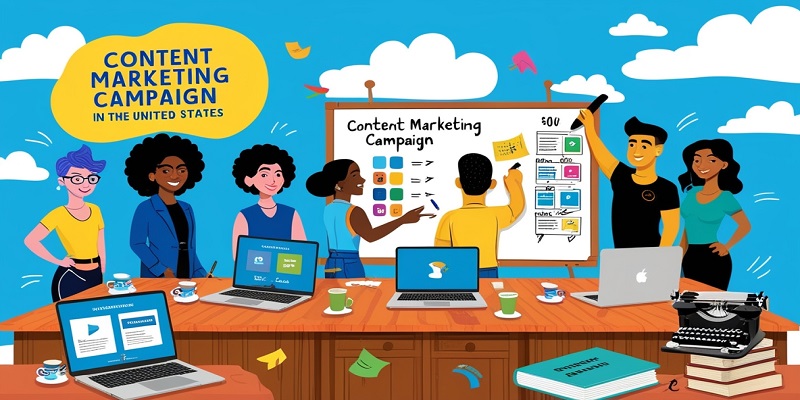A 10-Point Checklist for Launching a Content Marketing Campaign in the U.S.

Content marketing has emerged as a powerful strategy for businesses to engage with their audience, build brand authority, and drive conversions. However, launching a successful content marketing campaign in the U.S. requires careful planning, execution, and optimization. To help you navigate this process, we’ve put together a 10-point checklist that covers everything from strategy development to post-launch analysis. By following these steps, you can ensure your content marketing campaign is well-targeted, effective, and aligned with your business goals.
Define Your Target Audience
The foundation of any successful content marketing campaign is a clear understanding of your target audience. In the U.S., where consumer preferences and behaviors can vary significantly across different demographics and regions, it’s crucial to develop detailed buyer personas. These personas should include information such as age, gender, location, income level, interests, pain points, and purchasing behavior. By understanding who your audience is, you can create content that resonates with them, addresses their needs, and compels them to take action.
Set Clear Goals and Objectives
Before you start creating content, you need to define what you want to achieve with your campaign. Are you looking to increase brand awareness, generate leads, boost sales, or improve customer retention? Your goals will determine the type of content you create, the channels you use, and the metrics you track. Make sure your objectives are specific, measurable, achievable, relevant, and time-bound (SMART). For example, instead of setting a vague goal like “increase website traffic,” aim for something more concrete, such as “increase website traffic by 25% within six months.”
Conduct a Content Audit
A content audit is a critical step in launching a content marketing campaign. By analyzing your existing content, you can identify gaps, opportunities for improvement, and content that can be repurposed. Review your website, blog, social media channels, and any other platforms where you’ve published content. Look for pieces that have performed well and consider how you can expand on them. Also, identify content that’s outdated or no longer aligned with your brand’s messaging and make a plan to update or remove it.
Develop a Content Strategy
Your content strategy is the blueprint for your campaign. It should outline what type of content you’ll create, how often you’ll publish, and the platforms you’ll use to distribute it. In the U.S., where consumers are bombarded with content from multiple channels, it’s important to diversify your content types. Consider incorporating a mix of blog posts, videos, infographics, podcasts, and social media content to reach your audience through different mediums. Additionally, your content strategy should include an editorial calendar that maps out your content creation and publication schedule.
Optimize for SEO
Search engine optimization (SEO) is a crucial component of any content marketing campaign, especially in a competitive market like the U.S. To ensure your content ranks well on search engines, conduct keyword research to identify the terms your target audience is searching for. Incorporate these keywords naturally into your content, including in your titles, headers, meta descriptions, and body text. Additionally, focus on creating high-quality, valuable content that answers your audience’s questions and provides solutions to their problems. Search engines prioritize content that offers real value to users, so avoid keyword stuffing and prioritize readability.
Leverage Social Media
Social media is a powerful tool for amplifying your content and reaching a wider audience. In the U.S., where social media usage is widespread, platforms like Facebook, Instagram, Twitter, and LinkedIn offer valuable opportunities to engage with your audience and drive traffic to your website. When developing your social media strategy, consider which platforms your target audience is most active on and tailor your content accordingly. For example, if you’re targeting professionals, LinkedIn may be more effective than Instagram. Additionally, use social media to promote your content, engage with your followers, and participate in relevant conversations.
Implement Email Marketing
Email marketing remains one of the most effective ways to nurture leads and build relationships with your audience. To make the most of your email campaigns, segment your email list based on your audience’s preferences, behaviors, and demographics. This allows you to send personalized content that’s relevant to each segment, increasing the likelihood of engagement. Additionally, use email to promote your content, share exclusive offers, and drive traffic to your website. Make sure your emails are mobile-friendly, as a significant portion of users in the U.S. access their emails on mobile devices.
Collaborate with Influencers
Influencer marketing can significantly boost your content marketing efforts by leveraging the credibility and reach of influencers in your industry. In the U.S., consumers often trust recommendations from influencers more than traditional advertisements. When selecting influencers to collaborate with, consider their relevance to your brand, their audience size, and their engagement rate. Work with them to create authentic, high-quality content that aligns with your brand’s messaging and resonates with their followers. Whether through sponsored posts, product reviews, or social media takeovers, influencer partnerships can help you reach new audiences and drive conversions.
Monitor and Analyze Performance
Once your content marketing campaign is live, it’s essential to track its performance and analyze the results. Use tools like Google Analytics, social media insights, and email marketing software to monitor key metrics such as website traffic, social media engagement, email open rates, and conversion rates. By analyzing this data, you can identify what’s working and what’s not, allowing you to make informed decisions and optimize your campaign for better results. Additionally, consider conducting A/B testing to experiment with different content formats, headlines, and calls-to-action to see what resonates best with your audience.
Adjust and Optimize
Content marketing is not a set-it-and-forget-it strategy. To achieve long-term success, you need to continuously adjust and optimize your campaign based on the insights you gather. This might involve updating your content strategy, creating new content to address emerging trends, or refining your SEO tactics. Additionally, stay informed about changes in the U.S. digital marketing landscape, such as updates to search engine algorithms, shifts in consumer behavior, and new content formats. By staying agile and responsive, you can keep your content marketing campaign relevant and effective over time.
Conclusion
Launching a content marketing campaign in the U.S. requires careful planning, strategic execution, and ongoing optimization. By following this 10-point checklist, you can create a campaign that resonates with your target audience, achieves your business goals, and stands out in a competitive market. Remember, content marketing is a long-term strategy that requires patience, persistence, and a commitment to delivering value to your audience. With the right approach, your content marketing campaign can drive significant results for your business and help you build a strong, lasting connection with your customers.





